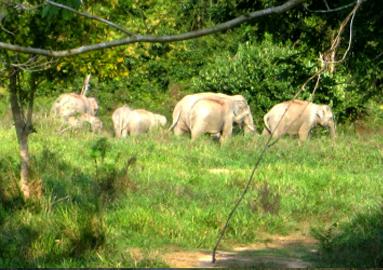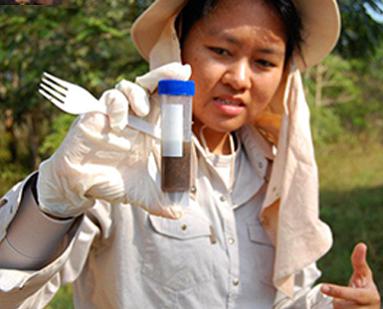Worata Klinsawat
To assess the impacts of habitat fragmentation on genetic structure and gene flow patterns among the tiger and elephant populations across the Tenasserim, Thailand.
Habitat fragmentation isolates formerly contiguous populations into small, disjunct populations. Tiger (Panthera tigris) and Asian elephant (Elephas maximas) populations in Thailand are highly fragmented, and suffer from restricted dispersal across human-dominated landscapes. Such subdivided populations are subject to inbreeding depression and loss of variation due to genetic drift, decreasing evolutionary potential and increasing extinction risk. Gene flow among populations can counteract these adverse genetic threat.

Elephants.
However, the level of gene flow and population genetic structure at the landscape scale remain unresolved. Using non-invasive landscape genetic sampling, population genetics, and landscape ecology, I will assess the remaining genetic structure and dispersal patterns among the tiger and elephant populations across the Western Forest Complex (WEFCOM) and Kaeng Krachan Forest Complex (KKFC), Thailand.

Sample.
Based on microsatellite loci genotyped from faecal samples, I will examine spatial genetic variation, genetic structure, and gene flow patterns of elephant populations between these two forest complexes. Baseline data about genetic structure and dispersal patterns will inform park managers about high-priority conservation areas needed to increase connectivity for maintaining metapopulation dynamics and long-term viability. Population genetic linkage will also help evaluate effectiveness of the current land-use management zoning and the Tenasserim corridors delineated in 2008 to facilitate movements of landscape species such as tigers, elephants, sambar, and great hornbill. The project start date is January 1st, 2012 and end date is December 31st, 2012. I will collaborate with Wildlife Conservation Society (WCS) Thailand and World Wildlife Fund (WWF) for sample collection. To increase government and NGO understanding of both the project and the larger conservation issues related to connectivity, I will provide them technical reports and a workshop non-invasive sampling and molecular genetic application towatd wildlife monitoring. This educational program will strengthen capacity of park rangers and NGO partners to implement continuous genetic monitoring of the wide-ranging, elusive species whose population dynamics and movement patterns across landscape matrices remain uncertain.